
Salty Sam’s Fun Blog for Children
Number 328
Press Gangs
Hello Everyone

Sometimes when you watch the news, you might see the reports of a person who has gone missing. lt is a worrying and upsetting time for their family.
Sometimes people are kidnapped and a ransom demand is issued. Sometimes they are kept as political prisoners by bandits or pirates.
Sometimes missing people are never seen again.
Years ago, the reason for a disappearance may well have been because someone was taken by a press gang.
Believe it or not, since mediaeval times it was legal for authorities working on behalf of the monarch to take men against their will to serve in the military and, especially, the Royal Navy.
Whenever the country was at war, large numbers of men would be needed to fight in campaigns. Press gangs were especially active during the 1600s and the 1700s but the practice even carried on into the early 1800s.
The press gangs would go from town to town to see who they could collect if numbers of volunteers for a war were not sufficient.
Mostly coastal towns were searched because it would not be necessary to transport the men too far to the navy ships docked in the port.
London was another place where men were often impressed and taken down to ships in the docks.
The gangs very often targeted dark passageways and streets and local taverns and pubs where a man intoxicated by alcohol was less likely to resist being taken.
They probably didn’t even know what was happening to them until it was too late.
Men took to drinking out of glass-bottomed tankards so they could keep an eye on the room while they drank. Have you ever seen a beer mug with a clear bottom?
The victims of the press gang would be whisked away to a ship and locked up until the ship left port.
Sometimes, the capture could be so violent that the men would die of their injuries because these would be left untreated. Once at sea, the men could stay on board for years at a time.
lt may have been many months before their families would learn of what had happened to their missing men folk.
Sometimes, the men were kidnapped from merchant ships because these men already had knowledge of seamanship. They would already know about sails and ropes and navigation. The press gangs favoured taking men with seamanship skills. lf ashore, they could be spotted easily by the ways they dressed and their general appearance and behaviour.
But ordinary labourers were taken too, and it was even known for a gang of armed men to raid churches in the middle of a service.
lf magistrates came across unemployed men, they were empowered to hand them over for service. ln Elizabethan times, the homeless in the street could be rounded up and put to work on ship.
All these measures were thought of as necessary for the upkeep of the country’s naval might.
A lot of Royal Navy sailors were in fact volunteers, but the numbers had to be augmented (increased) by impressments because there just weren’t enough of them.
And life aboard ship could be brutal and harsh. lt is easy to understand why not all men would necessarily choose to live a life as a Royal Navy sailor.
However, food rations were normally of quite good-quality and they were plentiful. And what was more, any man volunteering, could legally leave his money debts behind; which might have been quite an incentive for some.
Also the workload was less on a navy ship compared to a merchant ship because there were many more men on board to share the work.
There were many men aboard to sail the ship because many men were taken on board to man the cannon.
After the defeat of Napoleon in 1814, Britain ended the practice of impressment and in subsequent wars when men were conscripted they were given notification through official channels rather than taken at random by physical force.
lf they refused to fight, they might be put in prison or forced to do other jobs vital to the war effort. They were called conscientious objectors. They might have had religious or moral or other personal reasons for not wanting to fight. Some of them risked their own lives to help in battle (maybe to collect injured soldiers to take to hospital, for example) but did not want to kill others.
Nowadays, all men in the British forces are volunteers. They are called professional servicemen. But in some countries there is still conscription for men when they get to a certain age. That means they have to spend several months doing military training.
Bye bye everyone – don’t forget to subscribe to my blog!
lf you like my blog, please support it by telling all your friends and followers about it.
Thank you!
And see you again next Fun Friday!
Love and kisses
Salty Sam

www.christina-sinclair.com


Bill and Bob’s Joke of the Week![]()
![]()
Bob: l have just been watching a programme about how ships are put together.
Bill: Was it interesting?
Bob: lt was riveting!
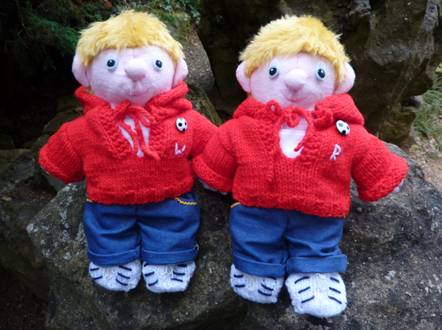
Salty Sam © Christina Sinclair 2015
Unauthorized use and/or duplication of material from this blog without express and written permission from this blog’s author and owner is strictly prohibited.
Links may be used to www.christina-sinclair.com

Picture Gallery

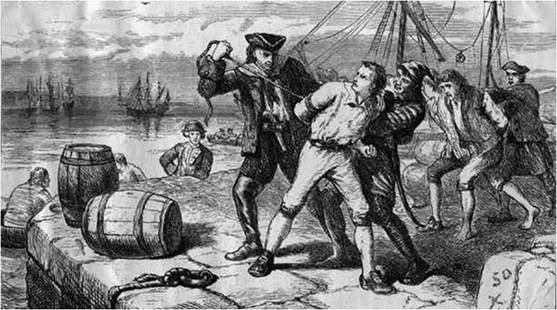


 THE SALTY SAM NEWS DESK
THE SALTY SAM NEWS DESK

This week, Henry went round to see Auntie Alice and tell her how much he enjoyed playing with the knitted ball she had made for him a while back.
In the meantime, Auntie Alice had made another ball of a different shape.
In fact, she had made three.
She said that as Henry liked playing with his ball so much he might like to have a go at juggling.
She showed him how to juggle with two balls. She said he should get good at that before he started trying to juggle with three.
Henry went off with his new balls.
He is going to practise juggling with them in his bedroom – he doesn’t want to bash the models of planets hanging from the ceiling of his playroom by playing with his new balls in there.
NEWSDESK MINIMAKE
JUGGLING BALLS
ROUND KNITTED JUGGLING BALL (KNIT TWO)
Using 4mm knitting needles and pink dk yarn cast on 30 stitches
Knit 4 rows of garter stitch
Knit 10 rows of stocking stitch
Don’t cast off – cut off yarn leaving a length of 30cm and thread this through your stitches
Knit another half to the ball in blue dk yarn
TO MAKE UP
- Match the bottom edges of the two pieces of knitting together with right sides facing
- Sew them together using over-sew stitching
- Pull one end tight
- Sew up side seams using the corresponding colour of yarn
- Turn the ball the right way out
- Stuff the ball so that it is hard
- Pull in the second end tightly and secure the yarn
- Sew around the rim of garter stitching to make a firm and round ball


*********************
TO ADVERTISE ON THIS BLOG
PLEASE CONTACT:
christina.sinclair.ads@aol.co.uk
*********************


Quick Quiz
Can you add words to ‘blue’ to make new words?
- A fruit often put in muffins
- A design of a building to be built
- A spring flower that grows in the woods
- A deceitful man (who marries several women one at a time and then murders them)
- A large housefly
- Aristocratic person
- A learned and forthright woman
- The second Full Moon within a calendar month
- Something to write with inside a pen
- Milk product coloured with cultures of mould




lt’s the Weekend!

HOW TO MAKE A LlTTLE KNlTTED SAlLOR DOLL
This little sailor has a stripy T-shirt, some bell-bottom trousers and a nice woolly hat to keep him warm as he crews his ship to sail the seven seas.
You could knit several sailors to give him some crew mates.
There is also a hammock for him to sleep in at night and a kit bag for him to pack some clean underwear, a spare hat and some photographs of his family to take away with him.
The kit bag is knitted in grey but you could also knit it in a very pale beige yarn to make it look like it has been made from canvas.
SAILOR DOLL FRONT (KNIT ONE)
Using 4mm knitting needles and white dk yarn cast on 10 stitches
Knit 2 rows of stocking stitch
Change to light blue dk yarn
Knit 2 rows of stocking stitch
Change to white
Knit 2 rows of stocking stitch
Change to light blue
Knit 2 rows of stocking stitch
Change to white
Knit 2 rows of stocking stitch
Change to light blue
Knit 2 rows of stocking stitch
Change to white
Knit 2 rows of stocking stitch
Change to pink
Knit 6 rows of stocking stitch
Change to brown
Knit 2 rows of stocking stitch
Don’t cast off
Cut off the yarn leaving a length of about 10-15cm and thread this through the stitches on your needle and pull the knitting needle away
SAILOR DOLL BACK (KNIT ONE)
Using 4mm knitting needles and white dk yarn cast on 10 stitches
Knit 2 rows of stocking stitch
Change to light blue dk yarn
Knit 2 rows of stocking stitch
Change to white
Knit 2 rows of stocking stitch
Change to light blue
Knit 2 rows of stocking stitch
Change to white
Knit 2 rows of stocking stitch
Change to light blue
Knit 2 rows of stocking stitch
Change to white
Knit 2 rows of stocking stitch
Change to brown
Knit 8 rows of stocking stitch
Don’t cast off
Cut off the yarn leaving a length of about 10-15cm and thread this through the stitches on your needle and pull the knitting needle away
ARMS (KNIT TWO)
Using 4mm knitting needles and light blue dk yarn cast on 8 stitches
Knit 2 rows of stocking stitch
Change to white
Knit 2 rows of stocking stitch
Change to light blue
Knit 2 rows of stocking stitch
Change to pink
Knit 2 rows of stocking stitch
Don’t cast off
Cut off the yarn leaving a length of about 10-15cm and thread this through the stitches on your needle and pull the knitting needle away
LEGS (KNIT TWO)
Using 4mm knitting needles and pink dk yarn cast on 10 stitches
Knit 10 rows of stocking stitch
Change to black yarn
Knit 2 rows of stocking stitch
Don’t cast off
Cut off the yarn leaving a length of about 10-15cm and thread this through the stitches on your needle and pull the knitting needle away
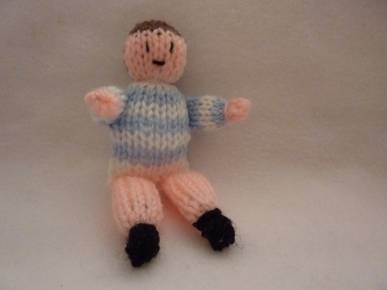
TROUSERS (KNIT TWO)
Using 4mm knitting needles and blue dk yarn cast on 15 stitches
Purl 1 row
Purl 1 row
Knit 10 rows of stocking stitch
Decrease 1 stitch at the beginning of the next 4 rows of stocking stitch
Knit 1 row
Knit 1 row
Cast off
HAT (KNIT TWO)
Using 4mm knitting needles and black or navy dk yarn cast on 12 stitches
Purl 1 row
Purl 1 row
Continue knitting in stocking stitch decreasing 1 stitch at the beginning of every row until you have 1 stitch left
Cast off
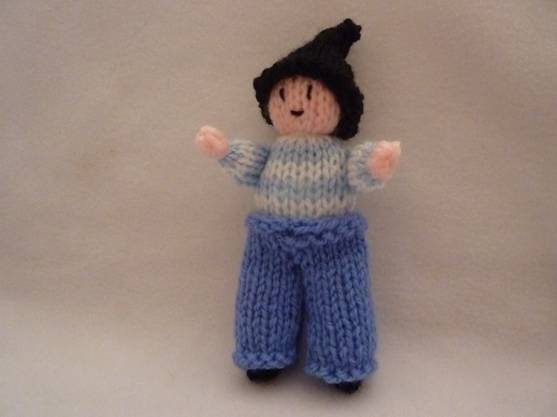
TO MAKE UP
- Sew up the side seams of the body and head right sides together using over-sew stitching and matching the stripes up
- Turn the body and head the right way out
- Pull the top of the head shut then stuff the head and body (you may need to put a couple of extra stitches in the top of the head in the same colour yarn as the hair to close up the little hole)
- Sew along the inner leg seams using over-sew stitching right sides together and turn the legs the right way out
- Tightly bind the ankles twice around with black yarn
- Stuff the legs
- Sew across the top of the legs and the bottom of the body from behind (lay the legs across the stomach as you work) to attach the legs
- Sew a strand of white yarn into the back of the neck and wrap it around the neck a couple of times, pull tight and secure the yarn into the centre back of the neck
- Embroider a face onto the front of the head using one strand of black yarn (you can pull double knitting yarn apart to get thinner strands)
- Sew along the under arm seams using over-sew stitching right sides together and turn the arms the right way out
- Tightly bind the wrists twice around with pink yarn
- Stuff the arms with the ends of the yarn left over from the knitting and a little stuffing as well if required
- Sew the arms securely to the sides of the body so that they point forward
- Sew up the front and back seams of the trousers using over-sew stitching and right sides together – then sew up the inside leg seams
- Sew up the side seams of the hat using over-sew stitching and right sides together
Turn the trousers and hat the right way out and dress the sailor.
TIP
You do not have to cut off the white and light blue yarn each time you start a new stripe – just carry your yarn up the side of the work.
If you would like the hat to sit high on the head, you will have to sew it on to stop it falling off.
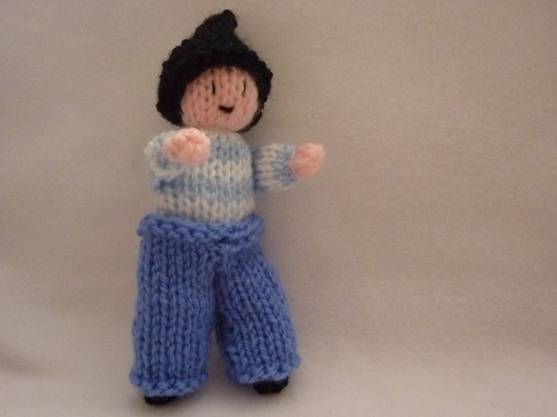
SAILOR’S HAMMOCK (KNIT ONE)
Using 4mm knitting needles and white or light brown dk yarn cast on 25 stitches
Knit 10 rows of garter stitch
Sl 1 (k1, p1) repeat the last 2 stitches to the end of the row
Repeat the last row 49 times
Don’t cast off
Cut off the yarn leaving a length of about 20-30cm and thread this through the stitches on your needle and pull the knitting needle away
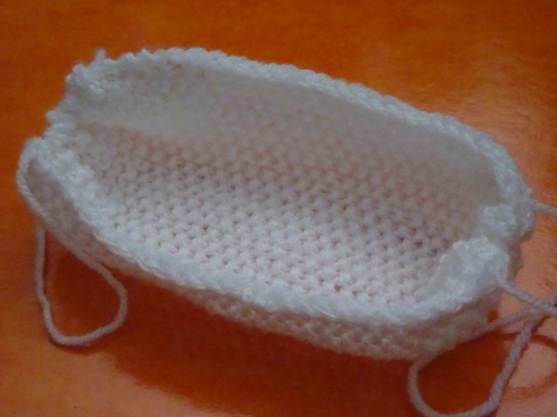
TO MAKE UP
Thread yarn along each end of the hammock and pull in
Then add a loop of 30cm of yarn to each end attaching it to the corners to hang the hammock up

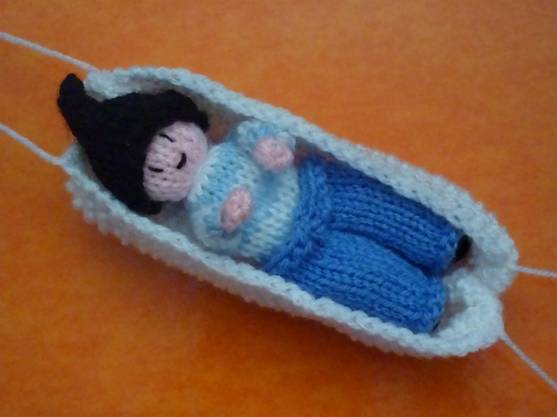
KIT BAG (KNIT ONE)
Using 4mm knitting needles and grey dk yarn cast on 18 stitches
Knit 16 rows of stocking stitch
Purl 1 row
Purl 1 row
Purl 1 row
Purl 1 row
Cast off
Sew up the side seam of the bag using over-sew stitching and right sides together.
Crochet 55 chains into a length of grey yarn leaving a small length of yarn at the end of the chain of about 10cm
Thread this cord through the channel at the top of the back and secure the ends into the bottom of the side seam
Using 4mm knitting needles and grey dk yarn cast on 25 stitches
Cast off
Sew this piece of knitting into a solid disc by sewing across the spiral several times in different directions and insert into the bottom of the bag
Sew into place
The sailor can carry the bag over his shoulder.
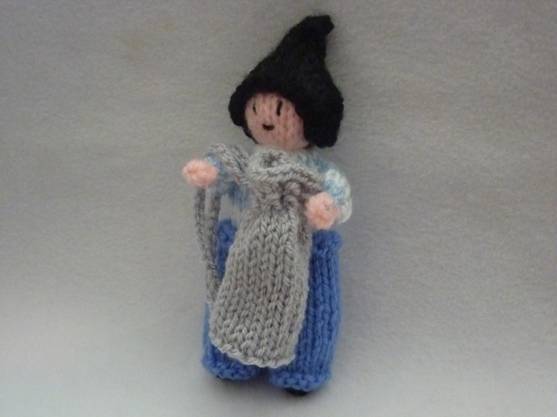
Please note that the material on this blog is for personal use and for use in classrooms only.
It is a copyright infringement and, therefore, illegal under international law to sell items made with these patterns.
Use of the toys and projects is at your own risk.
©Christina Sinclair Designs 2015


Quick Quiz Answers
- A fruit often put in muffins – blueberry
- A design of a building to be built – a blueprint
- A spring flower that grows in the woods – a bluebell
- A deceitful man (who marries several women one at a time and then murders them) – a bluebeard
- A large housefly – a bluebottle
- Aristocratic person – blue-blooded (so called because their skin was very white and you could see blue veins through it – labourers had tanned skin from working out in the fields)
- A learned (very educated) and forthright (opinionated) woman – a blue stocking
- The second Full Moon within a calendar month – a Blue Moon
- Something to write with inside a pen – blue ink
- Milk product coloured with cultures of mould – blue cheese (such as Stilton)
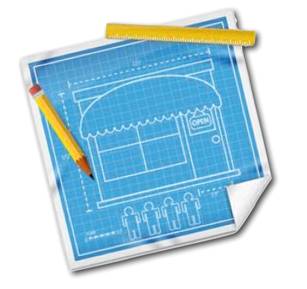
A blueprint

A look at life in the British Navy in the 1700s![]()
https://www.youtube.com/watch?v=cTBw24U-Mfg


